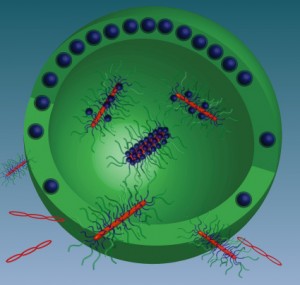Light-selective gene transfer using a nanomachine Light-responsive nanomachine integrates multiple functions in polymeric micelle


© Kazunori Kataoka et al.
When nanomachines are taken up into a cell, they are surrounded and isolated by a membrane. In response to the acidic environment of this enclosure, the nanomachine releases a drug that destabilizes the membrane when irradiated with light, delivering the cargo genes selectively to the nucleus of irradiated cells.
Techniques to transfer specific genes into target cells such as cancer cells (transfection) is a key methodology employed in the research and development of cutting-edge medical technology. Successful transfection requires a delivery system able to efficiently introduce a gene into a target cell. To date, virus vectors and lipid or polymer-based reagents were widely used in gene transfection into cultured cells, and their utility for localized administration has also been demonstrated. On the other hand, while gene therapy, including application to cancer treatment and regenerative medicine, requires a delivery system that can achieve selective in vivo transfection into a target tissue or cells in the body, it has been difficult to accomplish such selective transfection using virus vectors and reagents. In addition, there remain concerns over the safety of virus vectors and reagents.
In this research, Professor Kazunori Kataoka’s group in the University of Tokyo’s Graduate School of Engineering Department of Materials Engineering has developed a light-responsive nanomachine by integrating multiple functions into a three-layered polymeric micelle, which acts as a novel gene delivery system that greatly surpasses conventional delivery systems and provides selective and highly efficient transfection. By administering this nanomachine systemically to mice with subcutaneous tumors and then irradiating the tumors with light, the researchers for the first time accomplished light-selective gene transfer into a subcutaneous tumor.
The nanomachine developed here is systemically injectable and demonstrates better safety and selectivity than conventional virus and other transfection technologies. This nanomachine may be applied to the gene therapy of intractable diseases such as cancer and arteriosclerosis.
Paper
Takahiro Nomoto, Shigeto Fukushima, Michiaki Kumagai, Kaori Machitani, Arnida, Yu Matsumoto, Makoto Oba, Kanjiro Miyata, Kensuke Osada, Nobuhiro Nishiyama, and Kazunori Kataoka,
“Three-layered polyplex micelle as a multifunctional nanocarrier platform for light-induced systemic gene transfer”,
Nature Communications Online Edition: 2014/4/2, doi: 10.1038/ncomms4545.
Article link
Links
Graduate School of Engineering
Department of Materials Engineering, Graduate School of Engineering
Department of Bioengineering, Graduate School of Engineering
Center for Disease Biology and Integrative Medicine, Graduate School of Medicine
Kataoka Laboratory, Graduate School of Engineering
Kataoka Laboratory, Center for Disease Biology and Integrative Medicine, Graduate School of Medicine
COI STREAM – Center of Open Innovation Network for Smart Health (COINS) (Japanese)






